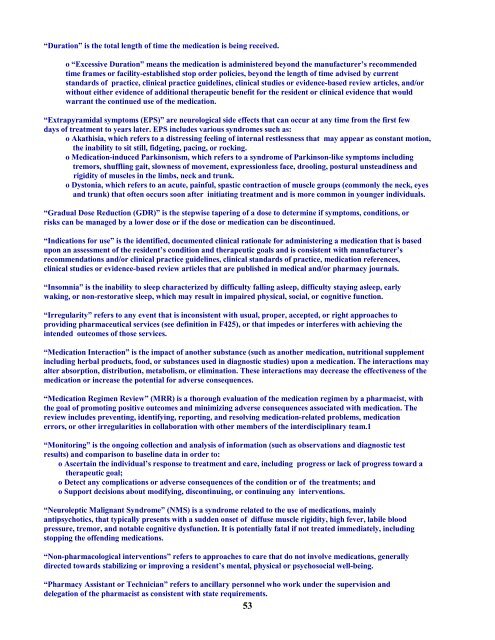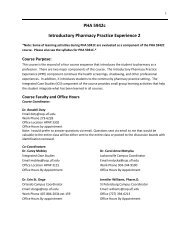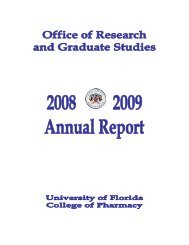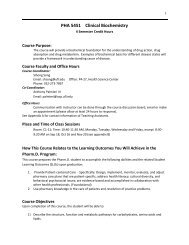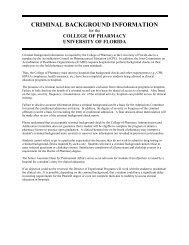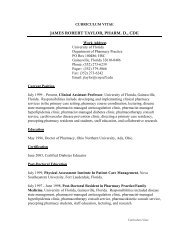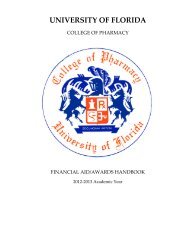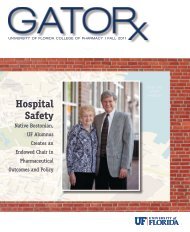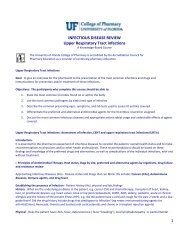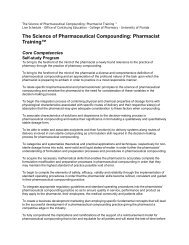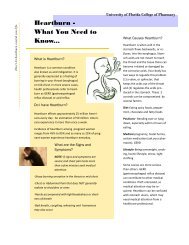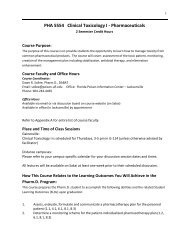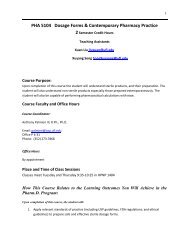Module 3: The Drug Regimen Review - College of Pharmacy ...
Module 3: The Drug Regimen Review - College of Pharmacy ...
Module 3: The Drug Regimen Review - College of Pharmacy ...
You also want an ePaper? Increase the reach of your titles
YUMPU automatically turns print PDFs into web optimized ePapers that Google loves.
“Duration” is the total length <strong>of</strong> time the medication is being received.<br />
o “Excessive Duration” means the medication is administered beyond the manufacturer’s recommended<br />
time frames or facility-established stop order policies, beyond the length <strong>of</strong> time advised by current<br />
standards <strong>of</strong> practice, clinical practice guidelines, clinical studies or evidence-based review articles, and/or<br />
without either evidence <strong>of</strong> additional therapeutic benefit for the resident or clinical evidence that would<br />
warrant the continued use <strong>of</strong> the medication.<br />
“Extrapyramidal symptoms (EPS)” are neurological side effects that can occur at any time from the first few<br />
days <strong>of</strong> treatment to years later. EPS includes various syndromes such as:<br />
o Akathisia, which refers to a distressing feeling <strong>of</strong> internal restlessness that may appear as constant motion,<br />
the inability to sit still, fidgeting, pacing, or rocking.<br />
o Medication-induced Parkinsonism, which refers to a syndrome <strong>of</strong> Parkinson-like symptoms including<br />
tremors, shuffling gait, slowness <strong>of</strong> movement, expressionless face, drooling, postural unsteadiness and<br />
rigidity <strong>of</strong> muscles in the limbs, neck and trunk.<br />
o Dystonia, which refers to an acute, painful, spastic contraction <strong>of</strong> muscle groups (commonly the neck, eyes<br />
and trunk) that <strong>of</strong>ten occurs soon after initiating treatment and is more common in younger individuals.<br />
“Gradual Dose Reduction (GDR)” is the stepwise tapering <strong>of</strong> a dose to determine if symptoms, conditions, or<br />
risks can be managed by a lower dose or if the dose or medication can be discontinued.<br />
“Indications for use” is the identified, documented clinical rationale for administering a medication that is based<br />
upon an assessment <strong>of</strong> the resident’s condition and therapeutic goals and is consistent with manufacturer’s<br />
recommendations and/or clinical practice guidelines, clinical standards <strong>of</strong> practice, medication references,<br />
clinical studies or evidence-based review articles that are published in medical and/or pharmacy journals.<br />
“Insomnia” is the inability to sleep characterized by difficulty falling asleep, difficulty staying asleep, early<br />
waking, or non-restorative sleep, which may result in impaired physical, social, or cognitive function.<br />
“Irregularity” refers to any event that is inconsistent with usual, proper, accepted, or right approaches to<br />
providing pharmaceutical services (see definition in F425), or that impedes or interferes with achieving the<br />
intended outcomes <strong>of</strong> those services.<br />
“Medication Interaction” is the impact <strong>of</strong> another substance (such as another medication, nutritional supplement<br />
including herbal products, food, or substances used in diagnostic studies) upon a medication. <strong>The</strong> interactions may<br />
alter absorption, distribution, metabolism, or elimination. <strong>The</strong>se interactions may decrease the effectiveness <strong>of</strong> the<br />
medication or increase the potential for adverse consequences.<br />
“Medication <strong>Regimen</strong> <strong>Review</strong>” (MRR) is a thorough evaluation <strong>of</strong> the medication regimen by a pharmacist, with<br />
the goal <strong>of</strong> promoting positive outcomes and minimizing adverse consequences associated with medication. <strong>The</strong><br />
review includes preventing, identifying, reporting, and resolving medication-related problems, medication<br />
errors, or other irregularities in collaboration with other members <strong>of</strong> the interdisciplinary team.1<br />
“Monitoring” is the ongoing collection and analysis <strong>of</strong> information (such as observations and diagnostic test<br />
results) and comparison to baseline data in order to:<br />
o Ascertain the individual’s response to treatment and care, including progress or lack <strong>of</strong> progress toward a<br />
therapeutic goal;<br />
o Detect any complications or adverse consequences <strong>of</strong> the condition or <strong>of</strong> the treatments; and<br />
o Support decisions about modifying, discontinuing, or continuing any interventions.<br />
“Neuroleptic Malignant Syndrome” (NMS) is a syndrome related to the use <strong>of</strong> medications, mainly<br />
antipsychotics, that typically presents with a sudden onset <strong>of</strong> diffuse muscle rigidity, high fever, labile blood<br />
pressure, tremor, and notable cognitive dysfunction. It is potentially fatal if not treated immediately, including<br />
stopping the <strong>of</strong>fending medications.<br />
“Non-pharmacological interventions” refers to approaches to care that do not involve medications, generally<br />
directed towards stabilizing or improving a resident’s mental, physical or psychosocial well-being.<br />
“<strong>Pharmacy</strong> Assistant or Technician” refers to ancillary personnel who work under the supervision and<br />
delegation <strong>of</strong> the pharmacist as consistent with state requirements.<br />
53


